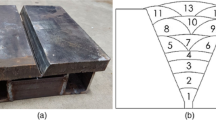Abstract
Vibrostrengthening is a fatigue-enhancement process, originally developed by the Russian aviation industry (Rumyantsev et al. 2004). A potential alternative to shot peening, currently a standard industrial surface treatment for fatigue enhancement, vibrostrengthening offers the potential for shorter processing times and uniform treatment of the surface, especially when dealing with fragile parts and complex part geometries. Vibrostrengthening is a modification of a vibratory finishing process in which the parts or workpieces and a medium of hard granular particles are vibrated together in a processing tub causing the particles to mechanically work the surface of the workpiece. In vibrostrengthening, the workpiece is fixed inside a vibratory tub, increasing the relative velocities between the particles in the medium and the workpiece. This gives rise to more aggressive mechanical working of the workpiece surface. The resulting plastic deformation at the surface produces a sub-surface compressive residual stress, which together with a better surface finish, is conjectured to improve the fatigue strength of workpiece. This paper is an experimental study of vibrostrengthening of aluminum components for fatigue life enhancement. The effects of various process parameters on the fatigue strength of a specimen are studied to experimentally characterize the process. These experiments also demonstrate that the vibrostrengthening process produces significant fatigue enhancement on experimental samples produced by machining. Further, these experiments verify that, in fact, fatigue enhancement in the vibrostrengthening process is a result of the combined effect of inducing a compressive residual stress field within the material and improving the material’s surface finish. Fatigue tests indicate that the fatigue enhancement of this process is comparable to, if not better than, shot peening. One important reason for such a favorable comparison, given the lower levels of residual stress that result from this process, is the superior surface finish it produces. A companion paper (Sangid et al. 2010) presents a study involving process visualization to understand and explain the process mechanics; further, a computational model is produced to characterize the fatigue enhancement of the process through the compressive residual stress field and surface topography.
Similar content being viewed by others
References
Rumyantsev Y, Pushkov V, Sirotkin O (2004) Final report: vibrostrengthening. National Institute of Aviation Technologies Internal Report: Exhibit 112Z
Sangid MD, Stori JA, Ferreira PM (2010) Process characterization of vibrostrengthening and application to fatigue enhancement of aluminum aerospace components, part II. Process visualization and modeling (in press)
Gane DH, Rumyantsev YS, Diep HT, Bakow L (2003) Evaluation of vibrostrengthening for fatigue enhancement of titanium structural components on commercial aircraft, Ti-2003 Science and Technology. Proc. 10th World Conf. on Titanium, Hamburg, July 2003
Kalpakjian S (1997) Manufacturing processes for engineering materials. 3rd edn. Addison-Wesley, pp 607
Wang S, Timsit RS, Spelt JK (2000) Experimental investigation of vibratory finishing of aluminum. J Wear 243:147–156
Yabuki A, Baghbanan MR, Spelt JK (2002) Contact forces and mechanisms in a vibratory finisher. J Wear 252:635–643
Baghbanan MR, Yabuki A, Timsit RS, Spelt JK (2003) Tribological behavior of aluminum alloys in a vibratory finishing process. J Wear 255:1369–1379
Ciampini D, Papini M, Spelt JK (2007) Impact velocity measurement of media in a vibratory finisher. J Mater Process Technol 183:347–357
Ciampini D, Papini M, Spelt JK (2008) Characterization of vibratory finishing using the Almen system. J Wear 264:671–678
Ciampini D, Papini M, Spelt JK (2009) Modeling the development of Almen strip curvature in vibratory finishing. J Mater Process Techol 209:2923–2939
Barter SA, Sharp PK, Holden G, Clark G (2002) Initiation and early growth of fatigue cracks in an aerospace aluminum alloy. Fatigue Fract Eng Mater Struct 25:111–125
Sharp PK, Clark G (2001) The effect of peening on the fatigue life of 7050 aluminum alloy. Aeronautical and Maritime Research Laboratory, Australian Government
Author information
Authors and Affiliations
Corresponding author
Rights and permissions
About this article
Cite this article
Sangid, M.D., Stori, J.A. & Ferriera, P.M. Process characterization of vibrostrengthening and application to fatigue enhancement of aluminum aerospace components—part I. Experimental study of process parameters. Int J Adv Manuf Technol 53, 545–560 (2011). https://doi.org/10.1007/s00170-010-2857-2
Received:
Accepted:
Published:
Issue Date:
DOI: https://doi.org/10.1007/s00170-010-2857-2




